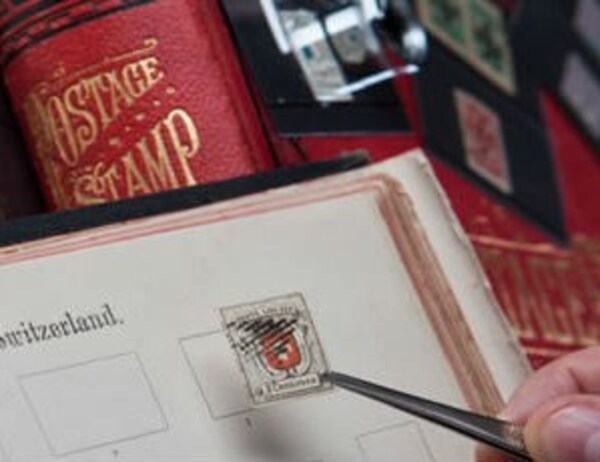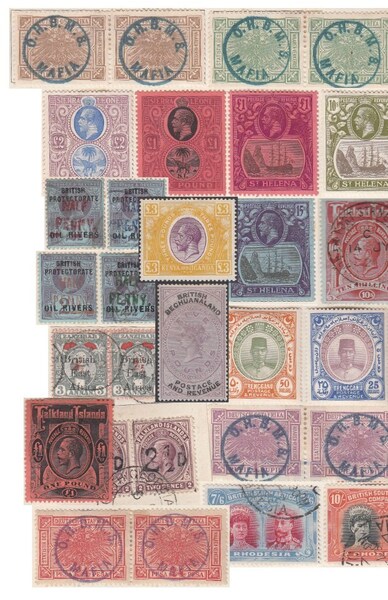As a child I would spend several weeks during the Summer holidays in Bournemouth, a large and reasonably well- heeled seaside town on the south coast of England. My grandparents lived there so as a holiday destination it fulfilled several family requirements at once, but it was also, alongside the City of Bristol, one of the stronger areas for stamp dealers outside of London. In fact the great Robson Lowe had part of his business there including an auction house.
During those delightful summers Bournemouth would host a large stamp fair. Proper booths housed dealers from all over the country including many of the biggest names in the business. I would wander around this event gazing at the beautiful and expensive stamps, my meagre pocket- money burning a hole in my pocket.
These were not the first stamp experts I had seen in action. My first and favourite stamp shop was in the Criterion Arcade in Bournemouth, I’d spotted an Ascension miniature sheet in the window which depicted mountains joined together in a single range across several stamps and had convinced my father to buy it for me. The chap in the shop, who many years later I interviewed for a job, was always welcoming despite my paltry spending power.
But it was that big stamp show where I first saw those dealers inspecting stamps and I recall mimicking some of this behaviour without really knowing what I was looking for!
I was eventually shown how to ‘look’ at stamps when at the ripe old age of 15 I began working at a stamp shop every Saturday. Some things cannot be taught as visual memory must be built over time and it’s only when a stamp appears different in comparison to all the others you’ve seen that you know you’ve ‘got it’. Perhaps the margins are too big for that particular issue or the colour is a bit strange, or perhaps the postmark is not of the type usually encountered on that stamp. Like many other areas in life, there’s nothing like experience!
However there is a definite skill in properly inspecting stamps beyond deciding if the basic appearance appeals to your eye. My old boss Ken Sandford (who named the firm) gave me my first lesson when he took a mint stamp from an approval book I was filling with stamps:
Boss “Tell me about the condition of this stamp”
Me “Errm, looks OK”
Boss “Is this stamp clean? Does it have blemishes?”
Me “No, it looks like a nice stamp”
Boss “We’ll see young man, we’ll see. Does it have all it’s perforation teeth?”
Me “Yes!”
Boss “Is it creased?”
Using my tweezers I tilt it toward the window, shining the light along the flat, smooth gummed surface “Perfect, no creasing”
Boss “Now do it again but check the front”
I turn the stamp over and tilt it towards the light which danced across the Queens face, I’m expecting to see the same flawless surface yet there is a diagonal crease across the stamp “Umm, there’s a big crease…” Boss “Do you know why there is a crease on the front but not on the back?”
I give him a blank look.
Boss “It’s had new gum brushed over the back and it’s hiding the crease”
I flinch, I can feel my face getting hot.
Boss “Now feel the stamp”
I’m imagining some sort of Jedi mind trick.
Boss “Why are you making that strange face?” he picks up the stamp and holding it between both fingers on the flat sides, not the perforated edges, he gently slides it between his forefinger and thumb whilst slightly flexing it “make sure your hands are dry and clean, your fingers are so sensitive that you should feel any imperfections. Now you try”
Just like my boss I hold the stamp in my tweezers and run my fingers over the stamp ever-so slightly flexing it as I go, I do this in several directions and it’s incredible “I can feel that crease!”
Boss “Anything else?”
Me “Yes, there’s a lump too!”
Boss “Correct. It’s had some sort of damage, either a thinned patch or a hole and it’s filled with something” he motions at the stamp again “now hold it to the light”
I hold it to the window but this time to allow the light to pass through the paper. Instead of a watermark there is a darker patch, just where I’d felt that lump “Yes, I see it now”
Boss “Right. Now take that magnifier and look at the design, especially the right- hand frame line”
“Umm.. it’s a bit of a different colour, but you can’t really tell without using the glass”
Boss “Correct, someone has repainted that frame line for some reason, the surface of the stamp was probably damaged and it’s been ‘improved’
I’m really in trouble now, just how damaged is this stamp?
Boss “Now look at the perforations down that side and tell me how they look”
I use the glass again, following my boss’s example I draw the small lens near my eye and anchor it as I move the stamp “they look fine”
Boss “You idiot. Look at the 5th and 6th holes”
I simply didn’t know what he wanted me to see, or say.
He’s getting impatient now and sighs, plainly disappointed with this stupid youngster “they are not perfectly circular holes; someone’s used some sort of tool to deepen the holes and make the perfs look longer!
I am now looking at a perfectly attractive mint stamp which turns out to have been creased, re-gummed, repainted, repaired and with enhanced perforations. It’s like the 6 million dollar man but worth less because of all the engineering, not more. My face must be glowing.
Boss “Do you know why I’ve shown you this?”
I’m 15 and really can’t figure out the answer which will cause me the least amount of trouble. Such is the mind of a schoolboy.
Boss “Because you put this stamp in an approval book and we might have sold it to a customer but at least I remembered to check your work. Our job is to protect our customers because they feed us!” There followed a look which would make Paddington Bear wither and a request that I make him a cup of tea.
He was right about our responsibilities to you, our clients and the reasons that I’ve played out this little episode of my early professional life is to hopefully entertain (I suspect many of you will recall beginning work at a time when your sensitivity to being told-off was not something your boss worried about!) and to also make the point that you should be careful where you buy your stamps from! We’ve been seeing some very badly graded stamps recently, often purchased from online sellers with little knowledge of philately, so stick with the professionals whilst honing your own skills and collecting will remain a pleasure and not a minefield!
Vincent Green


 General
General
 General
General
 General
General